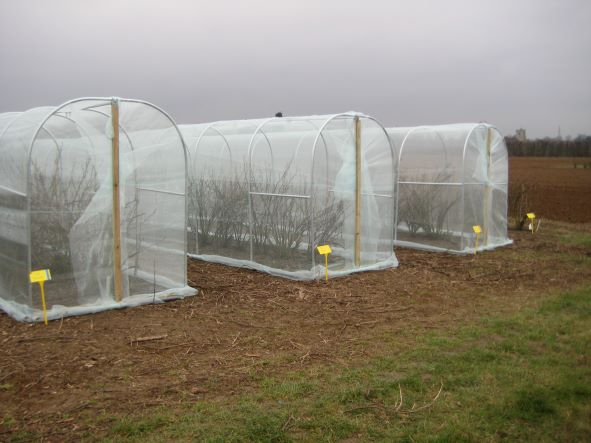Please click here to access the main AHDB website and other sectors.
- Home
- Knowledge library
- Botrytis in blackcurrant: effect of pollination
Botrytis in blackcurrant: effect of pollination
Pollination in blackcurrant can affect yields and fruit quality – find out more
Return to the main page: Developing novel biocontrol methods for pests and disease in blackcurrant
Effects of pollination: the survey
In the early years of the project, nine plantations were surveyed, identifying 15 species of wild bee foraging on blackcurrant flowers, many of which were ground nesting, solitary, Andrenid bees.
Very few honeybees were found foraging blackcurrant flowers, so they appear to play little part in the contribution to blackcurrant pollination.
Bumblebees from nest boxes and wild solitary bees were sampled from the plantations and examined for the presence of blackcurrant pollen.
60% and 38% of the bees had blackcurrant pollen on their heads, respectively, showing that they were foraging the flowers and, therefore, aiding pollination.
Caged field trials
Caged field trials showed that supplementing blackcurrant with Bombus terrestris nest boxes, at the point of flowers opening, increased yield and fruit size in Ben Hope and Ben Gairn.
Caged field trials
This was shown to be particularly important in a period of poor weather when the naturally occurring pollinating insects were less active.
In a field trial using Ben Gairn, the exclusion of insects from flowers in open field conditions demonstrated that insect pollination contributes up to 35% of fruit set.
Botrytis spores
There was some evidence that bees can act as vectors for Botrytis spores.
Of 20 B. terrestris sampled from nest boxes used in the trial, Botrytis was cultured from the legs of three bees and head and body of one bee.
Large field trials set up with and without managed bumblebees found virtually no difference in Botrytis levels in the fruits.
It was concluded that the benefit that bees provide in pollination far outweighed any downside of Botrytis vectoring.
Importance of pollinating insects
To achieve maximum pollination, it is vitally important that pollinating insects are present during the flowering period.
However, these insects need to be provided for before and after blackcurrant flowering to sustain populations and build up numbers year on year.
The landscape and surrounding land use can be manipulated to bolster numbers of wild solitary and bumble bees.
Providing nest sites for solitary bees through patches of bare south facing ground and also a wide diversity of flora to forage, will help to increase bee populations.

Bare south facing ground offers nesting sites for solitary bees
Solitary bees
Solitary bees that visit blackcurrant flowers (mainly ground nesting Andrenids), forage on a range of open flower plants, including species from the Brassicaceae, Rosaceae, Crassulaceae, Ranunculaceae and Asteraceae plant families.
Tests were also done to determine if insect pollination improved the nutritional status of fruit.
It was found that dry matter content of blackcurrant fruit was improved by insect visits, which may be attributable to more effective pollen transfer than wind alone.

A solitary bee nest
Useful links
AHDB funded research into blackcurrant botrytis control
Evaluation of fungicides for the control of Botrytis
Developing traps and thresholds for blackcurrant sawfly
Read the biocontrol in soft fruit guide
Download the bush fruit crop walkers' guide
Authors
These pages were originally authored by Michelle Fountain, Angela Berrie and Scott Raffle (NIAB) in 2015.
Topics:
Sectors:
Tags:


